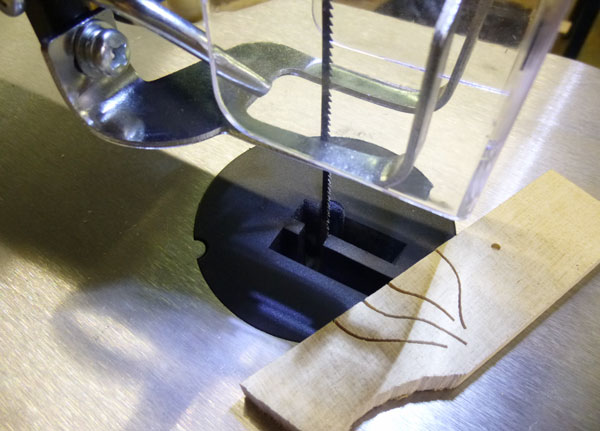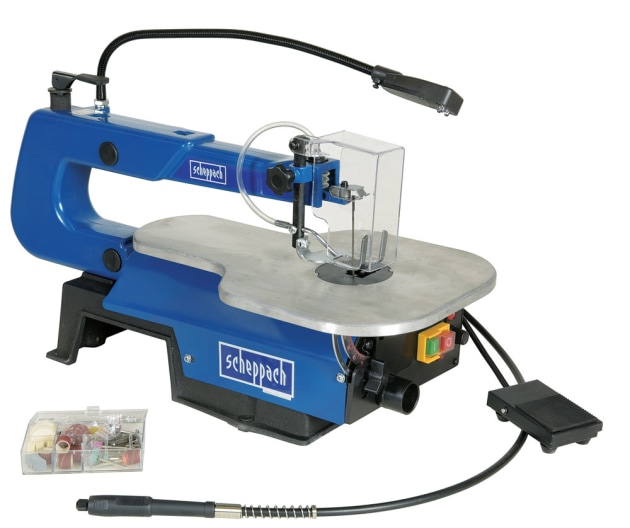Scheppach Deco XL Scroll Saw
Review: Andrew Potocnik
There’s a whole community of woodworkers out there who specialise in scroll saw work. They create two dimensional drawings cut into thin boards and need a machine capable of delicate cuts with negligible tear-out, plenty of support for large workpieces, and blades fine enough to provide a very fine pencil-thin saw kerf capable of cutting tight curves.
With these requirements in mind I was keen to see how this German saw manufactured in China performed, especially with a number of features highlighted on the packaging and website.
Weighing 11.8kg this saw is easy enough to move from its packaging to the workbench, whilst having enough weight to sit firmly on four rubber feet which absorb the minimal vibration generated as the saw is set in operation. The 240 volt motor hums along without generating excessive noise, which in short bursts for me didn’t require hearing protection.

Sized 630 x 320 x 380mm high, it’s ideal for a small workshop. The variable speed switch provides a range of 550–1600 strokes per minute. The length of stroke is 20mm, although clearance between the table and top of the vibrating arm is 50mm. In all reality saws of this type are generally designed to cut material of up to about 10mm before compromising quality of cut and accuracy.
The kit features a foot-operated switch which lets you use both hands to hold down work before engaging the saw to cut safely and accurately. This is an advantage, no matter your level of expertise in using a tool of this type. Keep in mind, this is only an on/off switch, the variable settings need to be manually altered on the main variable speed setting on the machine’s body.
This saw includes a screw-on flex drive that is easily fitted to the motor, and this is where the foot switch is most practical. Although the flexdrive appears quite lightweight at first glance, it is capable of gripping a variety of cutters, grinders and sanding attachments mounted to a 3.2mm shaft. The collet can be changed to grip smaller diameter shafts, but most of the attachments were 3.2mm in diameter and looked like standard kits available with other products.
When I switched to my own heavy duty burrs, the motor stood up and just kept going, but remember to go gently. A shortfall of this dual purpose set-up is that you cannot disengage the saw when using the flex drive, therefore the saw will run whilst you’re grinding or sanding away.
The saw uses pinned blades of 127mm length which are quick and easy to change. If you prefer non- pinned blades a pair of couplings allow for these to fed through narrow holes, however you’ll need to experiment to see just how fine a blade will tolerate the power of this saw.

Although I found the clear plastic safety guard intrusive it’s better for manufacturers to be safe rather than sorry. It’s worth noting that safety glasses should always be worn whenever using machinery, no matter how timid it may seem.
Tilting and locking the table from 0–45° to the left of the blade is easy enough, and while the saw generates minimal dust, there is a 35mm diameter vacuum connection below the blade while a pump action links to a hose which blows dust away from the blade.
In use I found the saw ran smoothly at all speeds, sitting firmly on my bench and emitting a low level of noise. The blade cut cleanly without tear-out on the underside of the 3mm Huon pine I was working on. The result was similar on some 6mm thick maple I had on hand.
Tight curves were a breeze to negotiate, and while the battery powered LED light is quite okay for general work, a more powerful light would be appreciated when performing intricate cuts.
Review machine from www.machineryhouse.com.au/W350
Andrew Potocnik is a woodworker and teacher who lives in Melbourne, see www.andrewpotocnik.com



